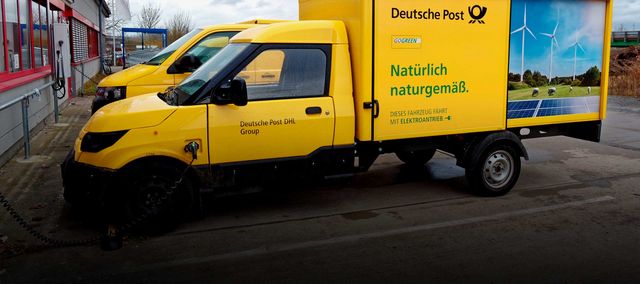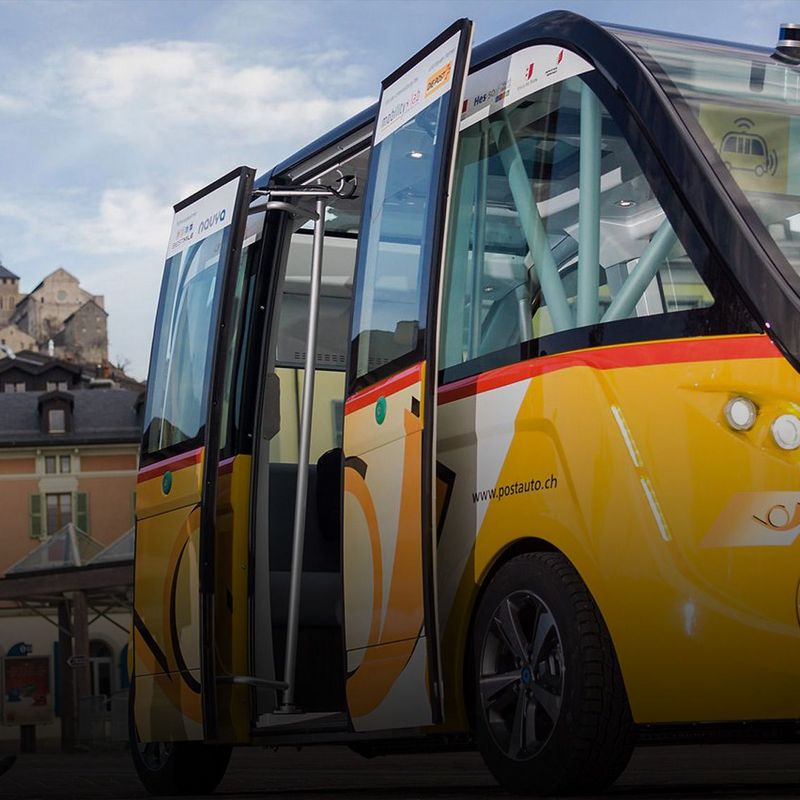5 September 2018
Electric delivery vans and trucks have in the past been far more the exception than the rule. Now, however, the electrification of delivery vehicles is gaining traction. First out of the starting blocks was the German post office with its StreetScooter. But other firms are now increasingly following suit.
Retail sales of electric cars to private customers are still sluggish. However, logistics companies are increasingly turning to electric mobility. In a number of German cities, courier services have been running on electricity as well as diesel for some time. Many experts consider urban delivery traffic to be the ideal field of application for electric mobility. A four-year project of the Fraunhofer Institute came to the conclusion back in 2016 that smaller electric delivery vans can already compete with diesel vehicles. It demonstrated that the daily rounds could be accomplished with just one battery charge and the car plugged in overnight to recharge. Generally speaking, the predictability of delivery traffic makes it particularly suitable for the use of electric vehicles in urban environments, stresses Christian Förster, electric mobility expert at TÜV NORD. After all, although private individuals are wary of purchasing an electric car because they might at any time want to set off on a long-distance holiday drive, the same drivers, when employed by delivery firms, cover similar distances every day. On the one hand, it’s a simple matter to work out how long the vehicles need to be plugged in overnight to be fully charged the following morning. On the other, daily distances of up to one hundred kilometres don’t necessarily require the biggest battery to be installed in the vehicle. And a small battery means lower purchase costs, less weight and smaller amounts of energy to get the vehicle moving.
6.000 der hauseigenen elektrischen StreetScooter bringen deutschlandweit Post und Pakete.
It is in the light of all these considerations that Deutsche Post has already opted to make significant use of electric delivery vehicles. 6,000 of the company’s own electric StreetScooters are already bringing letters and parcels to customers’ doors across Germany. In the medium term, the intention is to electrify the entire fleet of 50,000 mail vehicles. To meet the growing demand from municipalities and cottage industries, Deutsche Post opened a second production plant in May 2018 in Düren in North Rhine-Westphalia. This means that it is now possible to produce up to 20,000 electric delivery vans of various sizes every year.
There’s no doubting the fact that it is becoming increasingly important to make delivery transport more environmentally friendly. After all, according to calculations of the German government, about one-third of traffic volume in cities is already accounted for by goods or delivery traffic. And this volume is increasing: in the first half of 2017 alone, the courier, express and package delivery industry in Germany grew by 6.6 percent. And there is no end in sight. By 2021, the industry anticipates sales growth of more than 30 percent. Electrification of delivery vehicles would not only reduce nitrogen oxide and local emissions of CO2 to zero. Particulate air pollution from the internal combustion engine would also be eliminated. And even the particulate matter generated by brake pad wear would be greatly reduced, explains Christian Förster. This is because the regenerative braking system in electric vehicles takes the strain from the mechanical brakes as well as charging up the batteries every time the brakes are applied. Whereas the fuel consumption of conventionally powered vehicles rises in urban stop-and-go traffic situations and, with it, environmental pollution, electric vehicles really come into their own in cities. This applies even more to parcel delivery vehicles, whose engines are switched off and on again every few metres. “An electric vehicle is obviously better suited to this kind of terrain,” Förster says. After all, unlike an internal combustion engine, an electric motor doesn’t need to warm up to operating temperature. “In stop-and-start mode, the exhaust cleaning function of a conventionally powered car tends to work less efficiently because it also needs to reach a certain temperature,” Förster adds.
To make life easier for its couriers, Deutsche Post wants to go a step further. So that the postman doesn’t need to keep getting back into the vehicle to drive ten metres to the next delivery address, the idea is for the delivery van to trundle along autonomously next to the driver. The first tests have already been carried out. In the long term, the vans might even be able to navigate the city streets completely autonomously. This doesn’t mean that the delivery driver will be redundant. After all, the van won’t be able to take packages up to the third floor. The idea is rather for the robot delivery vehicles to free up the courier to sort letters and packages or do office work. First of all, however, some legal issues need to be addressed before the autonomous StreetScooters can be given the green light to take to public roads in a practical test.
As far as electrification is concerned, the established car makers have now started to catch up. Mercedes has announced its intention to equip its commercial vans with an electric drive. This will begin with the eVito, which is to go on sale from September 2018. At the beginning of the year, Hermes and Mercedes-Benz launched their collaboration with a pilot phase in Hamburg and Stuttgart. By 2020, the parcel service provider aims to be using 1,500 of the electric vans in metropolitan areas throughout Germany. Amazon, too, is seeking to enter into partnership with Daimler to use electric battery power to take parcels the last mile to customers in the Ruhr region. Leading the way here are 30 vehicles at its Bochum site, to be followed by another 70 in Düsseldorf and other logistics centres.
Electric heavy goods vehicles are also poised to make an entrance. Daimler delivered the first twelve of its fully electric eCanter lorries to European customers at the end of 2017. The 7.5-tonne truck is being used, for example, by DHL for city-centre deliveries. The aim is to be producing about 500 lorries per year from 2019. Volvo Truck, too, intends to start mass production of an electric model in the same year. The Fl Electric tips the scales at a total weight of 16 tonnes and is designed for use in the city - for instance as a bin lorry or delivery distribution vehicle. Since electric trucks make significantly less road noise, residents will also benefit from a reduction in noise pollution. This should make it possible to deliver goods by night, thereby reducing daytime traffic congestion in cities. After all, this is accounted for to a large extent by delivery vehicles.
It is estimated that, at peak times, delivery traffic is responsible for 80 percent of all traffic jams. This should come as no surprise: after all, in many places there is no suitable parking for such vehicles. Goods vehicles often double-park, drastically hiking the risk of congestion. It’s for this reason that goods delivery traffic should be pooled more efficiently and, where possible, taken off the roads. Assistance in this regard should be forthcoming from “city hubs” - urban collection points like those being trialled in Frankfurt and Berlin. Parcel service providers can deliver shipments which are already pooled for the various delivery areas and can then be taken the last mile to their destination on delivery bikes. These would be able to circumvent traffic jams and make twice as many delivery stops as delivery vehicles. What’s more, the operating costs over their entire lifetime would be significantly lower than those of a van.
To date, the parcels and packages have been brought to the micro-depots by truck. But the same job could in the future be done by trams. This, at least, is being discussed in Berlin. According to the considerations of the Senate department for the environment, transport and climate change, this would take some of the night-time strain off the railways and, at the same time, reduce the lorry traffic coming into Berlin. Whether trams really will soon be carrying packages in Berlin is an open question. The exploratory talks between the city and the transport and logistics companies are still at a very early stage. But some of the benefits of the tram are obvious: they don’t block the roads. And they are electric from the word go.
You may also like
ABOUT
© privat
Christian Förster is a Project Manager for E-mobility at the TÜV NORD GROUP and an expert on alternative fuels and propulsion concepts at the Institute for Vehicle Technology and Mobility (IFM).



